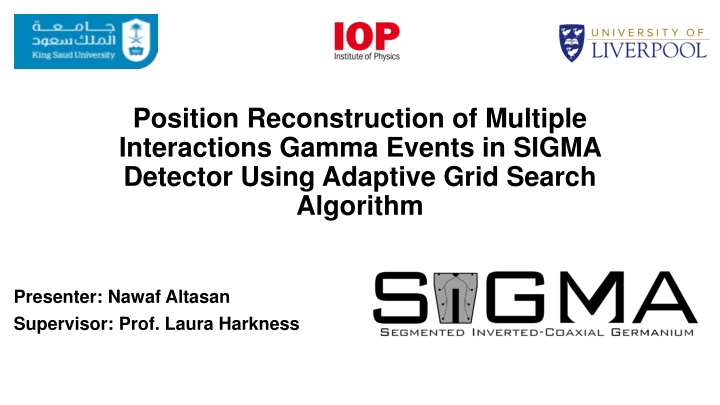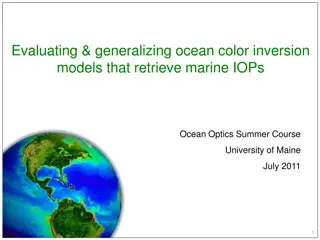
Advanced Position Reconstruction in SIGMA Detector Using Grid Search
"Explore the innovative use of an adaptive grid search algorithm for reconstructing multiple interactions in gamma events within the SIGMA detector. Learn about the detector's capabilities, pulse shape analysis, and the adaptive grid search process for precise interaction positioning. Discover the potential applications in gamma-ray imaging and tracking studies." (280 characters)
Download Presentation

Please find below an Image/Link to download the presentation.
The content on the website is provided AS IS for your information and personal use only. It may not be sold, licensed, or shared on other websites without obtaining consent from the author. If you encounter any issues during the download, it is possible that the publisher has removed the file from their server.
You are allowed to download the files provided on this website for personal or commercial use, subject to the condition that they are used lawfully. All files are the property of their respective owners.
The content on the website is provided AS IS for your information and personal use only. It may not be sold, licensed, or shared on other websites without obtaining consent from the author.
E N D
Presentation Transcript
Position Reconstruction of Multiple Interactions Gamma Events in SIGMA Detector Using Adaptive Grid Search Algorithm Presenter: Nawaf Altasan Supervisor: Prof. Laura Harkness
What the purpose of SIGMA? Gamma ray Tracking SIGMA is a High-purity germanium position sensitive detector. Position sensitivity enables the detector to perform the following: 1) Gamma-ray imaging, which is used in medical and industrial applications. 2) Gamma-ray tracking, which is used for nuclear structure studies. Gamma ray Imaging 1 Gamma-ray imaging sketch reference: Mu oz, E., Barrio, J., Etxebeste, A., Ortega, P.G., Lacasta, C., Oliver, J.F., Solaz, C. and Llos , G., 2017. Performance evaluation of MACACO: a multilayer Compton camera. Physics in Medicine & Biology, 62(18), p.7321.
Longitudinal Radial What is SIGMA? SIGMA is a p-type Segmented inverted coaxial high-purity germanium detector. The detector consists of 18 segments and a point contact. It includes 8 azimuthal segments, 8 longitudinal segments and 2 radial segments. Azimuthal Azimuthal 2
Single- and Multi-fold events Single-fold (fold 1) events occur when only one segment collects charge. Multi-fold events occur when more than one segment collect charge. In multi-fold events (fold n) the experimental pulse is a linear combination of all interactions scaled by their energy deposit. Single-fold ???? = ????; ??< 1 ? Multi-fold events are useful for tracking and imaging. Multi-fold 3
Pulse Shape Analysis (PSA) PSA involves comparing the experimental signal to all possible signals within the segment in 1 mm grid space. The best match is determined by calculating the minimum figure of merit (FoM). (?? ??)2; ? = ????????????,? = ????????? ??? = ? A grid search is computationally viable for segment fold 1 events. However, it is computationally expensive to do it for higher folds. The comparison is performed against the ADL-simulated database of all possible signals. Segment Fold Min Possible Combinations Max Possible Combinations 1 2700 42000 7.3 x 106 966 x 106 2 9 x 1010 2.12 x 1014 3 4
Adaptive Grid Search (Two-steps search) The adaptive grid search is a two-step process that divides the search area into coarse and fine searches. The coarse search should indicate the volume of interaction. The fine search involves a 1 mm grid search within the coarse search area to determine the exact interaction positions. 5
AGS on Fold 1 Events. GS The integrity of the adaptive search was verified by testing it on pencil beam experimental fold 1 events and comparing the results to those of a grid search. The results of the grid search (GS) and adaptive grid search (AGS) are nearly identical. The AGS is an order of magnitude faster than the GS. AGS 6
Testing AGS on Fold 2 using GEANT4 The AGS PSA was tested on GEANT4 data, where the interaction positions and energies were extracted and mapped to the closest points in the database. The test was conducted under ideal conditions to determine the theoretical limits of the AGS PSA. The experimental uncertainties that affect the PSA include electrical noise and time alignment uncertainties. 7
Results of Ideal Conditions The mean Euclidean distance deviation (MEDD) was found to be 2.28 mm. The PSA has an intrinsic error due to being stuck in local minima while searching for the best match. These results depend on the selected coarse and fine points. 8
Test on Experimental Data Testing on experimental data requires known positions to assess PSA performance. The PSA was tested on fold 2 collimated source data, with a beam spot of 1 mm The point closest to the true position was chosen as the scatter event. The PSA is assessed based on the identified positions of the scatter events. Reference: Alharbi, A., 2024. A Study of the Position Resolution of the Segmented Inverted-coaxial GerMAnium (SIGMA) Detector for Gamma-Ray Tracking and Imaging (Doctoral dissertation, University of Liverpool). 9
Test on Experimental Data Testing on experimental data requires known positions to assess PSA performance. The PSA was tested on fold 2 collimated source data, with a beam spot of 1 mm The point closest to the true position was chosen as the scatter event. The PSA is assessed based on the identified positions of the scatter events. 10
Results of Experimental PSA The results are presented as a cumulative difference across four different source positions. The plot represents the variation between the true and found positions in x and y. The standard deviations for x and y are 4.43 mm and 4.40 mm, respectively. The MEDD is 5.24 mm. 11
Conclusion The AGS algorithm was tested on the SIGMA detector for single- and multi-fold events. The AGS results on fold 1 events is identical to GS. The AGS was tested on simulated fold 2 events, yielding a MEDD of 2.28 mm under ideal conditions. Tests on collimated source experimental data were conducted, with PSA standard deviations for x and y being 4.43 mm and 4.40 mm, respectively. The MEDD in experimental data is 5.24 mm 12
Thank You for listening Any questions? 13
APPENDIX APPENDIX 14
ADL Simulation Acquiring the detector response across all possible positions experimentally for PSA is time consuming process. Thus, we use the simulation toolkit ADL to simulate the response of the detector signals in all possible interactions. ADL stands for AGATA Detector Library The output of the simulation is based on the physical properties of the detector. Plot Reference: Alharbi, A., 2024. A Study of the Position Resolution of the Segmented Inverted-coaxial GerMAnium (SIGMA) Detector for Gamma-Ray Tracking and Imaging (Doctoral dissertation, University of Liverpool). 15
ADL Verification Verifying the ADL output is done by using coincidence measurements coupling the detector with multiple BGO detectors and a pencil beam source. After verifying the ADL database, we can start using Pulse Shape Analysis (PSA) on the detector. 16
Results of Experimental PSA On radial distribution the PSA has a standard deviation of 3.21 mm. In azimuthal the PSA has a standard deviation of 64 deg 17






















